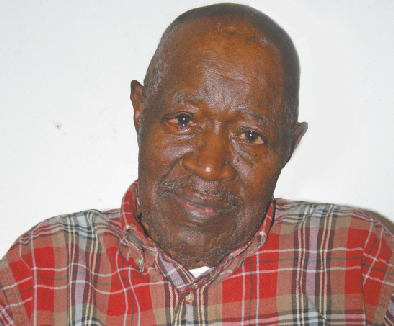Who's Here: Lee Hayes, Tuskegee Airman

So what would 89-year old East Hampton resident and former Tuskegee Airman Lee Archer Hayes like to do for his 90th birthday? A chuckle, the voice warm, clear, resonant, he doesn’t miss a beat: “make it.” His humor and the exactitude of his remembered incidents about his life in the nation’s unique—and segregated—World War II Army Air Corps unit, The Tuskegee Airmen, would make many younger folk envious—and the modesty and grace with which he talks about being black in the South in the 1940s (“some bad stuff”), after growing up on a friendly all-white street in Amagansett, instructive.
Born in Virginia, Hayes’ family moved to The East End when he was nine, after his father’s job in a sawmill disappeared during The Depression. An uncle who lived in Sagaponack got his father a job on a dairy farm, and his parents and siblings soon found themselves the only blacks around in their new community. Significantly, Hayes suffered no racism and in fact was welcomed enough by his neighbors to be called a “Bonacker.” His fact-checker kicks in, amid another chuckle. He has a 267 telephone prefix, so everyone thinks he lives in Amagansett, but it’s really East Hampton, though close to the border and reflecting a time when 324 telephone lines were put in on his street.
After attending the Amagansett School, he went to East Hampton High School, where his passion was “math, physics too.” These were easy subjects for him (he particularly loved geometry) and would stand him in good stead when he got into a training unit as a navigator/bombadier. He had had to drop out of high school after three years, however, to help support his family—he was the oldest of 13 children. He had always wanted to fly but his mother repeatedly said no. He kept after her. She finally yielded, but by then (1943), 21-year-old Lee Hayes was drafted into the Army, which meant into a segregated unit. His dream to fly remained. Despite being told that it was fruitless for a black man to apply to be a pilot (and that he needed at least two years of college), he and a friend took the test required of potential candidates and did so well—actually coming out Number 1 and Number 2—and finishing the exam long before the time limit—that there was no way he would be denied entry into the flight training program. Being stationed, though, in Florida, Mississippi, Kentucky, Texas, as well as in Tuskegee, Alabama, home base for pilot training, he faced a different kind of denial.
He remembers being told in Mississippi not to “step off the base” because “who knows.”
And then there was the incident in Midland, Texas where he went for more bombardier training. He had boarded a bus and, seeing a free seat, took it. It was not in the back of the bus, and it was next to a white girl. An MP soon showed up—MPs were white—and told him to move to the back. He replied, probably as evenly as he recounts the event, “I don’t see a seat back there.” He was at this point a cadet, the MP “an ordinary sergeant.” He was “manhandled” and he struck back. It was not long before the “ruckus” became a cause celebre. Military officers arrived to get his side of the story, but he firmly refused to say what happened. What was the point, he told them, “You won’t believe me, anyway.” He was not correct. His account was duly noted even by an Inspector General sent down from Washington D.C., he was told. He would not be disciplined. On the other hand, he would not receive an apology. The idea was not to make waves. Not long after this incident, he went to the movies on the base where, traditionally, blacks had to sit in the balcony. Another delicious chuckle: An usher came to greet him: “Where would you like to sit, sir?”
Arguably, Hayes’ most disturbing confrontation with segregation was the Alabama landing lights issue. He and three training buddies were in their B-25, getting ready to land. It was night. As per regulations, he called in to the control tower for info about wind direction, speed, possible obstacles.
As part of this routine they would give their plane number. It was TU108. Instructors were white. The plane number would have made it clear who Hayes was, the “T” standing for Tuskegee, and Tuskegee standing for the all-black unit. There was also, it was said, a giveaway “voice tone,” though he had been told that his own was not easy to place. There was no problem, however, placing the motive of the control tower personnel in what they went on to do. Instead of providing “only runway lights,” which Hayes had requested, the tower saturated the field with blinding floodlights. Despite repeated calls, the floodlights remained. Fortunately, the plane, which did go off course because of what the floods did to depth perception, barely missed a 100-foot embankment, Hayes working the brakes just short of a friction fire. How convenient had it gone otherwise. He says quietly but with that tell-tale chuckle—then it could have been said that the boys “just killed themselves.” The war ended one month before Hayes finished his flight training (thus, Hayes never saw action, but the story of the Tuskegee airmen was recently told in the 2012 movie Red Tails.) However, Hayes had, in effect, been fighting a different kind of war at home for civil and human rights. When he came back to East Hampton and brought his discharge papers to EHHS, he was, to his surprise and delight, given a diploma, and then encouraged to go to college at Farmingdale State, which he did. He studied aircraft maintenance and operation. And he finally did get a commercial license. And he found professional work in carpentry and construction. It might also be said that he found a new career talking about his experiences.
A self-effacing man, Hayes came to understand the importance of his recollections when, after a talk one day at Brookhaven National Laboratory, a stranger in the audience, a black man who identified himself as a commercial pilot, came up to thank him for clearing the path for African Americans. He’s told these stories before, Hayes says almost apologetically, but adds, “I can always tell them again,” and he does, with good humor, faithfulness to the facts and an appreciation of what the stories mean—or should mean—especially to new generations. In this regard, he has spoken in schools during Black History Month, and this year he was honored at the Suffolk County Historical Society in Riverhead with a plaque and testimony to his achievement in helping blacks overcome 300 years of “adversity and limited opportunities” to serve and lead.
The year 2012 marks 100 years since a northern philanthropist by the name of Julius Rosenwald (president of Sears, Roebuck & Co.) gave a man he greatly admired by the name of Booker T. Washington seed money to start a school for the vocational training and economic advancement of American blacks in the rural South. The school, known then as The Tuskegee Normal and Industrial Institute For Colored People, now Tuskegee University, was located in the county seat of Macon, Alabama, in the east-central part of the state. Approximately 30 years after that, a new flight training facility was opened not far from Tuskegee at Moton Field, named for Robert Russa Moton, who took over as principal of Tuskegee after the death of Booker T. Washington in 1915. Though the origin of “Tuskegee” is uncertain, it’s been suggested by some folk etymologists that it’s related to “Taska” which means “warrior” in Muskhogean, the language of a Southern branch of an Alabama Indian tribe. Apocryphal? Perhaps, but how apt, if not, considering what Lee Hayes fought for in his own quiet, determined way.



